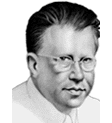Ernest Lawrence
After earning a BS from his home state's University of South Dakota (1922) and a PhD in Physics from Yale University (1925), Ernest Orlando Lawrence joined the Physics faculty at the University of California at Berkeley (1927). Here, he soon invented one of the most essential apparatus of nuclear physics: the cyclotron (granted patent #1,948,384 in 1931).
At that time, particle accelerators – devices used to shoot electrons, charged protons, or ions at atomic nuclei – were linear. That is, the particles were shot at the target by a burst of static electricity along a straight path. Lawrence and others realized that they could give the particles much greater speed within a smaller space if they could build momentum by whirling them in a spiral before releasing them.
Lawrence made this possible by inventing the "cyclotron." Using this device, an electromagnetic field keeps a beam of charged atomic particles in orbit within a structure made of two opposed D-shapes, while a radio-frequency electric charge boosts the particles' speed each time that they cross the gap between "dees." In this way, particles can be brought to very great speeds before they are released to collide with the target. By analyzing such collisions between charged particle and nucleus, scientists learn much about the structure and characteristics of atoms and can even produce artificial radioactivity.
Lawrence himself pioneered the use of radiation to combat cancer, he successfully treated hyperthyroid, and he paved the way for the isolation of Uranium-235 (which allowed the U.S. to create the atomic bomb). He won the Nobel Prize in Physics for 1939. In addition, he founded the Lawrence Berkeley Lab (1930s) and the Lawrence Livermore Lab (1952). Both are still internationally renowned nuclear research facilities. Later generations of particle accelerators – synchrocyclotron, isochronocyclotron, and superconducting supercollider – can all be considered improvements to Lawrence's original cyclotron.


